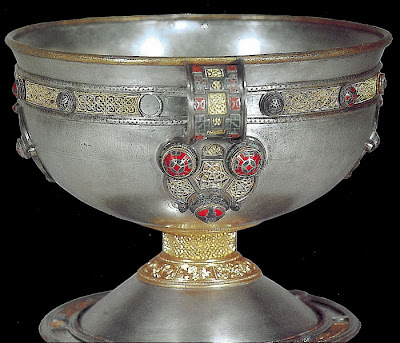 |
| The Ardagh Chalice, from Ireland, c. 8th century CE. |
I have missed too many meetings of the Joseph Campbell Foundation’s New York City Chapter this year, but that wasn’t going to happen Wednesday night, when a trip uptown was scheduled to enjoy a lecture at the 92nd Street Y. The C.G. Jung Foundation for Analytical Psychology sponsored “C.G. Jung and the Mythology of King Arthur,” for which Dr. Beth Darlington, professor of English at Vassar College, skillfully explained the Arthurian legends in the Jungian context. She also is a board member of the Foundation’s Jung Institute of New York, which trains mental health professionals in Jungian analysis, and she herself is a psychoanalyst in private practice.
When examining the psychological aspects of the rituals and symbols of Freemasonry, it is inevitable that Jung’s ideas – for example, on archetypes, individuation and the collective unconscious – will factor into one’s studies, even unintentionally. And when examining Jung himself, one learns of the importance he placed on the myths inspired by the legendary King Arthur, how elements of the stories gratified his theories on the psyche.
But anyway, when viewing these legends and considering them as “cultural dreams,” the Masonic eye can’t help but see thematic connections. There are far better sources to read about the Arthurian legends than I could provide myself, so without getting into too much detail – and there are many trails to follow in different directions – I’ll quickly sketch what I think are the two main branches of the myth.
 |
| Joseph of Arimatheaea, as painted by a monk of the Brotherhood of St. Seraphim of Sarov in Norfolk, England. |
1. The Grail is the chalice from which Christ drank at the Last Supper, and into which His blood was collected during the Crucifixion, and which was brought to Glastonbury by Joseph of Arimathaea. Christians know this symbol in their Eucharist.
 2. The Grail is not a vessel at all, but is a stone, possibly an emerald which had fallen from Satan’s possession during his fight with God. From this understanding, it also could be construed as the Philosopher’s Stone of Alchemy.
2. The Grail is not a vessel at all, but is a stone, possibly an emerald which had fallen from Satan’s possession during his fight with God. From this understanding, it also could be construed as the Philosopher’s Stone of Alchemy.Either way, it is the subject of The Quest. In his own travels, Masonic Man ventures from East to West in search of That Which Was Lost.
Here are the other Grail-Craft parallels that appear to me:
There is a theory that Arthur himself is based on King Athelstan, to whom Masonic legends, dating nearly as far back as the dawn of the Arthurian myth itself, attribute Masonic parentage.
A temple is built on the Mountain of Salvation for the purpose of housing the Grail, and an Order of Grail Knights is formed. The Grail keeper is a king. Solomon built his temple on Mt. Moriah for the purpose of housing the Ark and providing his people a religious centrality. He is king, but there is a priestly Order.
This king suffers a wound; he survives but is in agony. His torment causes his idyllic land to degenerate into the Waste Land. In other words, the leader suffers an act of violence, and in the absence of his leadership, there is confusion and suffering. The return of the Grail restores peace and harmony.
The Grail, as a vessel, has the power to nourish the peoples of the Waste Land. It is bottomless. Think Cornucopia.
Three seekers succeed in finding the Grail, with varying degrees of success. There is Galahad, the virtuous knight; Perceval, the Fool character; and Bors, the ordinary man. All three are present the final time the Grail is used ritually. This takes place in the Heavenly City in the East.
There is a ritual question that must be asked by the true quester: Whom does the Grail serve? In other versions, the question is: What ails you? The answering of these questions allows the wounded king to recover (but die in peace) and for the waters of the land to return to the Waste Land, restoring its beauty and bounty.
Throughout, there are noticable opposites and dualities. There are events in the East and West. Themes intertwine Christian and pagan beliefs. Human and divine. Good and evil. Males and females are at odds. "Only conscious compassion can heal these divisions," said Professor Darlington. That compassion is that ritual question, the asking of which triggers the rebirth of the Waste Land, not very different from how the loss of the Word throws the workmen into chaos until the giving of the substitute, upon the highly symbolic Five Points of Fellowship, allows for the completion of KST.
One final note for you neo-Templars: In at least one Grail legend, the Knights Templar themselves appear as guardians of the Grail Castle. Their suppression in the early 14th century had the effect of almost outlawing the Grail myths, which had to be perpetuated sub rosa.






























































2 comments:
Excellent!
When William Blake wrote the haunting hymn,"Jerusalem", and asked the question, "and did those feet in ancient time walk upon England's mountain green?", he was referring to a legend that purports that St. Joseph of Arimethea brought the child Jesus to Britain.
Post a Comment